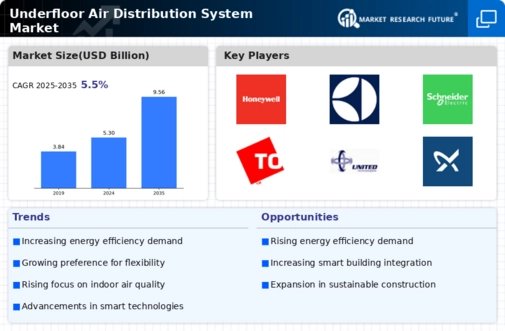Energy Efficiency Demand
The increasing emphasis on energy efficiency is a primary driver for the Underfloor Air Distribution System Market. As organizations strive to reduce operational costs and minimize their carbon footprint, underfloor air distribution systems offer a viable solution. These systems can enhance energy efficiency by allowing for better temperature control and reduced energy consumption. According to recent data, buildings utilizing underfloor air distribution can achieve energy savings of up to 30% compared to traditional systems. This trend is likely to continue as regulatory frameworks increasingly mandate energy-efficient practices, further propelling the demand for underfloor air distribution systems.
Enhanced Indoor Air Quality
The growing awareness of indoor air quality (IAQ) issues is significantly influencing the Underfloor Air Distribution System Market. With rising concerns about health and productivity, organizations are prioritizing systems that improve air quality. Underfloor air distribution systems facilitate better ventilation and air circulation, which can lead to a reduction in airborne contaminants. Studies indicate that improved IAQ can enhance employee productivity by as much as 10%. As more businesses recognize the importance of a healthy work environment, the demand for underfloor air distribution systems is expected to rise, reflecting a shift towards healthier building practices.
Rising Construction Activities
The resurgence in construction activities across various sectors is a notable driver for the Underfloor Air Distribution System Market. As new commercial and residential buildings are developed, there is an increasing demand for innovative HVAC solutions that offer flexibility and efficiency. Underfloor air distribution systems are particularly appealing in modern construction due to their ability to accommodate open floor plans and changing workspace needs. Recent statistics indicate that the construction industry is experiencing robust growth, which is expected to further stimulate the demand for underfloor air distribution systems in new projects.
Regulatory Compliance and Standards
The evolving landscape of building regulations and standards is a critical driver for the Underfloor Air Distribution System Market. Governments and regulatory bodies are increasingly implementing stringent guidelines aimed at improving energy efficiency and indoor air quality. Compliance with these regulations often necessitates the adoption of advanced HVAC systems, including underfloor air distribution systems. As organizations seek to meet these standards, the demand for such systems is likely to increase. Furthermore, the potential for financial incentives associated with compliance may further encourage the adoption of underfloor air distribution systems in various sectors.
Adaptation to Smart Building Technologies
The integration of smart building technologies is reshaping the Underfloor Air Distribution System Market. As buildings become increasingly automated, the need for adaptable and efficient air distribution systems grows. Underfloor air distribution systems can be seamlessly integrated with smart technologies, allowing for real-time monitoring and control of air quality and temperature. This adaptability not only enhances user comfort but also optimizes energy usage. Market data suggests that the smart building sector is projected to grow significantly, which will likely drive the adoption of underfloor air distribution systems as part of comprehensive building management solutions.

















Leave a Comment